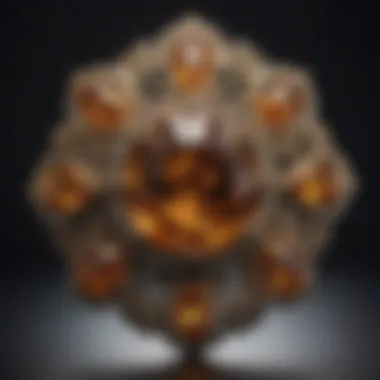The Significance of November Birthday Gemstones


Intro
November is a month rich in significance for those born under its skies, particularly in relation to the gemstones associated with their birthdays. The two primary stones linked to November are topaz and citrine. The relevance of these gemstones extends beyond mere aesthetics; they embody history, metaphysical properties, and cultural meanings that have evolved over time. This article aims to unravel the layers surrounding these remarkable stones, providing meaningful insights into their characteristics, properties, and care. By the end, readers will discover how these gems not only represent a birth month but also resonate with a deeper significance that persists through the ages.
Gemstone Overview
Definition and characteristics
Gemstones are natural minerals, rocks, or organic materials that have been cut and polished to be used in fine jewelry. Each gemstone possesses unique characteristics that determine its value and desirability. Topaz is typically recognized for its vibrant hues, ranging from golden yellows and warm ambers to cosmic blues.
Citrine, on the other hand, is well-known for its sunny yellow color, evoking warmth and brightness, often believed to bring positivity and abundance to its wearer. Both these stones are revered not just for their beauty, but also for their historical and spiritual significance.
Classification of gemstones
Gemstones are broadly classified into two main categories: precious and semi-precious. Topaz falls under the precious category due to its durability and brilliant luster, whereas citrine, classified as semi-precious, still holds significant value and charm. The classification does not merely denote worth but reflects the cultural and historical narratives woven into each stone.
Properties of Gemstones
Physical properties
The physical properties of gemstones play a vital role in their evaluation. Topaz exhibits a hardness rate of 8 on the Mohs scale, marking it as quite durable enough for daily wear, making it suitable for rings and bracelets. Citrine rates at a 7 on the Mohs scale, indicating that while it is still a relatively tough stone, it requires more delicate handling than topaz.
Chemical properties
The chemical makeup of a gemstone often influences its appearance and properties. Topaz is a silicate mineral composed largely of aluminum and fluorine, which imparts its distinctive crystal structure and colors. Citrine, a variety of quartz, consists primarily of silicon dioxide. Its hues arise from trace minerals and heat treatments, showcasing nature's fascinating ability to create stunning variations out of simple chemical structures.
"Topaz and citrine are not just decorative; they are rich in history and meaning, often seen as symbols of love, nobility, and fidelity."
Understanding both the physical and chemical properties is crucial for anyone looking to appreciate or invest in these gemstones. Their uniqueness extends beyond their physical form into the realm of human experience, intertwining our lives with their lasting allure.
Prelims to November Birthstones
November is notable for a rich selection of gemstones, primarily topaz and citrine. Each carries distinct properties and historical significance. Understanding these stones is essential for anyone interested in the world of birthstones, especially those born in this month. November's crystals not only enhance jewelry designs but they also resonate with specific energies and meanings.
The significance of these gemstones goes beyond their aesthetic appeal. They embody characteristics believed to influence those who wear or possess them. This article aims to explore the vast landscape of November birthstones, covering aspects such as their historical context and the symbolism they represent.
Historical Context
Topaz and citrine have been valued across cultures and centuries. Topaz, recognized as the primary gemstone for November, finds its roots in ancient civilizations. The Romans believed it could improve eyesight, while Egyptians associated it with the Sun god Ra. This connection to divine energy solidified its importance in the cultural fabric of various societies.
Citrine, on the other hand, is often referred to as the merchant's stone. Historically, it was believed to bring prosperity and success in business ventures. Its yellow hue was thought to carry the warmth of the sun, making it a symbol of optimism and clarity. The stone was favored in ancient Greece, and its appeal has transcended time, still captivating gemstone enthusiasts today.
Symbolism of November Gemstones
Both topaz and citrine offer a wealth of symbolism.
- Topaz is often linked to wisdom, tranquility, and self-realization. It is believed to enhance personal insight and creativity. This gemstone promotes mental stability and is said to provide strength to those who wear it.
- Citrine symbolizes abundance, prosperity, and joy. Its vibrant color is thought to promote positive energy and is associated with the achievement of goals. Citrine encourages confidence and resists negativity, making it a favored choice for those in business or creative pursuits.
In summary, the significance of November birthstones lies in their rich histories and the powerful symbolism associated with them. Both topaz and citrine narrate stories that connect the wearers with ancient beliefs and energies, making these stones much more than mere decorations.
Topaz: The Primary November Gemstone
Topaz holds a prominent position as the primary gemstone associated with November birthdays. Its importance is rooted in a blend of historical significance, extensive symbolism, and its various beneficial properties. In this section, we will explore the physical properties of topaz, its diverse color variations, the locations where it is sourced, and its metaphysical attributes. This comprehensive understanding enriches the appreciation for this remarkable stone.
Physical Properties


Topaz is a silicate mineral, primarily composed of aluminum and fluorine. Its chemical formula is Al₂SiO₄(F,OH)₂. Its hardness is rated 8 on the Mohs scale, making it a durable choice for jewelry. The crystal structure is prismatic with a perfect cleavage in one direction, which can sometimes complicate cutting and polishing. Topaz is also known for its high luster, producing a glassy finish that enhances its visual appeal.
Color Variations
Topaz is unique for its wide spectrum of colors. The most common shade is the golden-yellow variety, but it can also be found in blue, pink, reddish-orange, and even colorless forms. The blue topaz, which is often treated to achieve its hue, is particularly popular in contemporary jewelry. Each color of topaz has its own aesthetic and sometimes symbolic significance, adding a layer of meaning for wearers.
Source Locations
Topaz is found in several regions globally, with notable sources including Brazil, Russia, Nigeria, and Pakistan. Brazil is renowned for producing high-quality Imperial topaz, famed for its rich golden and reddish tones. Each locality contributes to the uniqueness of the topaz mined there, influencing factors like color intensity and clarity.
Metaphysical Properties
Believers in metaphysical properties attribute various benefits to topaz. It is often regarded as a stone of clarity and focus, thought to aid in decision-making and enhance creativity. Additionally, topaz is believed to bring joy and good fortune to its wearer. Many people wear or carry this gemstone to promote relaxation and alleviate stress, enhancing overall emotional well-being.
"Topaz is a powerful ally for success and personal growth. Its vibrant energy inspires confidence and helps to manifest inner passions."
Through examining physical attributes, stunning colors, sourcing locations, and metaphysical claims, topaz proves itself to be much more than just a birthstone. It serves as a symbol of strength and clarity, making it a favored choice among gemstone enthusiasts.
Citrine: The Other November Birthstone
Citrine is not just a secondary choice for November birthstones, it holds its own significance and allure among gemstone enthusiasts. This vibrant yellow to golden-orange stone is renowned for its unique characteristics and benefits. Natural citrine is relatively rare, which enhances its appeal. Many people appreciate citrine not only for its physical beauty but also for its purported healing properties and metaphysical associations.
Chemical Composition
Citrine is a variety of quartz, composed primarily of silicon dioxide (SiO2). The yellow coloration arises from the presence of iron impurities. The level and state of iron can affect the depth and hue of citrine. Typically, the more stable the iron, the richer the color. This chemical composition contributes directly to its durability. Citrine scores a solid 7 on the Mohs scale of hardness, making it suitable for various types of jewelry.
Distinctive Features
Citrine exhibits several distinctive features that set it apart. Its natural color can range from pale yellow to a deep amber hue. Unlike some gemstones, citrine's clarity is often impressive, offering transparency that enhances its visual appeal. Its hexagonal crystal structure is common, and it may showcase a brilliance that can rival diamonds in the right conditions. Many collectors favor citrine for its unique color variations, which can provide an impressive range during gemstone selection.
Geographic Availability
Citrine is primarily found in Brazil, which is known for producing high-quality stones. Other notable sources include Madagascar and Peru. The geographical availability of citrine adds to its charm, as each region can impart slightly different characteristics to the stones. Brazil, in particular, is celebrated for its large and vibrantly colored citrine, contributing to its prominence in the market.
Healing Properties
Citrine is often associated with prosperity and positive energy. Many believe that this gemstone can help increase motivation, activate creativity, and encourage self-expression. Some even claim that citrine acts as a protective stone, shielding the wearer from negative energy. Healing practitioners often use citrine for its supposed ability to aid in digestion and improve overall well-being. While scientific evidence supporting these claims remains limited, the anecdotal support from users is widespread.
"Citrine is known as "the merchant's stone" because of its believed ability to attract wealth and success."
Citrine is versatile and works well in various settings and styles, making it a popular choice for both casual and formal wear. Its allure, combined with its unique properties, marks it as a gemstone worth considering for anyone interested in November birthstones.
Comparative Analysis: Topaz vs. Citrine
This section explores the differences and similarities between topaz and citrine. Both gemstones are associated with November births, yet they possess distinct characteristics. Understanding these differences aids in selecting the right gemstone based on personal preferences or intended uses. This comparative analysis highlights visual elements, market factors, and overall significance of both stones.
Visual Differences
Topaz typically presents in a range of colors including blues, pinks, and yellows. The blue variety, especially, is a favorite due to its vibrant hue. Important to note is the clarity as well; topaz generally has remarkable clarity and brilliance, making it visually appealing in jewelry.
Citrine, on the other hand, is primarily yellow to brownish-orange. This stone radiates warmth. Citrine has a glassy luster, contributing to its charm. When placed side by side, one can note the richness of citrine's color compared to the varied palette of topaz. Each stone's color draws different emotional responses and cultural associations.
Popularity and Availability
In terms of popularity, topaz is often favored for its diverse colorations. Its ability to be heat-treated enhances its appeal in the jewelry market. Certain colors, particularly the imperial topaz, are rarer which can increase demand. Since it is well-known across many cultures as a birthstone, it often has a wide market presence.


Citrine, while also popular, especially amongst those who prefer warm tones, can be found more readily in various jewelry settings. Its affordability plays a role in its accessibility to a broader audience. Many people appreciate citrine for its supposed healing properties, which can influence its demand, particularly in holistic and spiritual communities.
Market Value
Market value differs between topaz and citrine which can be decisive for collectors and buyers. Topaz, particularly the rarer varieties, tends to have a higher price point. The highest quality imperial topaz can fetch significant amounts in the market. This positioning reflects its rarity and desirability among gemstone collectors.
Conversely, citrine is more affordable and has a larger supply in the market. The price of citrine is notably lower than that of high-quality topaz. This cost-effectiveness enables more people to own this beautiful gemstone. As a result, while citrine may lack the traditional high value associated with topaz, it remains popular for its aesthetic appeal and energetic symbolism.
"Understanding the comparative aspects of topaz and citrine is crucial for informed choices, particularly in jewelry and gemstone collecting."
Selecting Quality November Gemstones
Choosing high-quality gemstones is essential for any November birthday celebration, especially when considering the potential emotional and financial investments involved. Quality influences not only the aesthetic appeal but also the longevity of the gems. When buying topaz or citrine, one must pay close attention to several elements that can affect overall satisfaction with the purchase. Understanding the criteria for selection can ensure that you acquire a piece that is both beautiful and lasting.
Criteria for Selection
To determine the quality of November gemstones, several criteria should be analyzed:
- Clarity: Look for inclusions or blemishes in the gem. Higher clarity usually indicates greater value.
- Cut: The gemstone's cut affects its brilliance. A well-cut stone reflects light wonderfully, enhancing its overall beauty.
- Color: For topaz and citrine, vibrant and deeper color shades are often more desirable. Evaluate the color saturation closely.
- Carat Weight: Heavier stones may be more valuable, but larger size alone does not determine quality.
- Origin: Some gemstones are valued based on where they are sourced. Understanding the mine can sometimes indicate quality and rarity.
Evaluating Authenticity
Ensuring that you purchase genuine topaz or citrine is crucial. Counterfeit gemstones can easily mislead buyers. Consider these tips:
- Seek Expert Opinions: Consulting with a jeweler or gemologist can provide insights into the authenticity of a stone.
- Check for Certification: Reputable gemstones should come with a certification from an accredited laboratory. This document confirms that the stone is indeed what it claims to be.
- Conduct Visual Inspections: Look for signs of wear or unusual characteristics that might signal a fake. A genuine stone has distinct qualities that artificial versions do not replicate.
"Authenticity establishes the trust and value of a gemstone. Without it, even the most dazzling stone loses its worth."
Understanding Certification
Gemstone certification helps buyers confirm the quality and authenticity of their purchases. Here are important points regarding certification:
- Reputable Laboratories: Certificates should come from recognized gemological institutions, such as the Gemological Institute of America (GIA) or the International Gemological Institute (IGI).
- Detailed Assessment: The certificate should include specifics about clarity, color, and cut as well as any other relevant information that supports the gemstone's authenticity.
- Market Value Implications: A certified gem often carries a higher resale value due to the trust factor involved. Buyers can feel assured of the stone's quality, leading to more informed purchasing decisions.
Selecting quality November gemstones requires diligence and thorough evaluation. By understanding the specific criteria for selection, evaluating authenticity, and recognizing the importance of certification, buyers maximize their chances of acquiring beautifully enduring pieces.
Caring for November Gemstones
Caring for November gemstones is critical for maintaining their beauty and enhancing their longevity. Topaz and Citrine, the two primary stones associated with this month, come with unique properties and need specific types of care. Proper maintenance ensures that these gemstones remain stunning and valuable over time. This section covers essential cleaning techniques and storing tips tailored to preserve the quality of these gems.
Cleaning Techniques
Keeping November gemstones clean is essential, as dirt and oils from skin can dull their brilliance. Here are effective cleaning methods for both Topaz and Citrine:
- Mild Soap Solution: Mix a few drops of dish soap in warm water. Soak the gemstone for a few minutes. Use a soft cloth or a gentle brush to remove grime.
- Ultrasonic Cleaners: If the stones are set in jewelry, ultrasonic cleaners can be effective. However, exercise caution, as some settings may not withstand ultrasonic waves.
- Avoid Harsh Chemicals: Do not use bleach or strong household cleaners, as these can damage the surface of the gemstones.
It is important to remember that different gemstones react differently to cleaning. Always ensure methods are suitable for Topaz and Citrine.
Storing Tips
Proper storage plays a vital role in preserving the luster of November gemstones. Consider these storing tips:
- Separate Storage: Always store Topaz and Citrine separately from other gemstones and jewelry pieces to prevent scratching.
- Soft Pouches: Use soft cloth pouches or lined boxes to avoid any impact. Soft cases prevent scratches that can tarnish their appearance.
- Controlled Environment: Keep your gemstones in a stable environment, away from direct sun exposure or extreme temperature changes.
The right care can significantly impact the lifespan and value of your gemstones. With suitable techniques, you can keep them looking as stunning as the day you acquired them.


These considerations about caring for November gemstones not only protect your investment but also enhance their overall appeal, ensuring these beautiful stones remain cherished for years.
Cultural Significance of November Gemstones
Understanding the cultural significance of November gemstones is essential to grasp their place in history and society today. Topaz and citrine are more than mere objects of beauty; they are imbued with meaning, mythology, and value across different cultures and time periods. Recognizing these aspects enriches one's appreciation for these stones, especially for enthusiasts, collectors, and designers alike.
Historical Beliefs
Throughout history, gemstones have held profound significance. In ancient civilizations, topaz was believed to possess protective qualities. The Egyptians regarded it as a stone of divine favor, often associating it with the sun god Ra. This belief highlighted topaz as a bearer of light and life, intended to bring wisdom, strength, and joy to its owner. Additionally, it was thought to ward off nightmares and enable success in endeavors.
Citrine, on the other hand, has been associated with prosperity and abundance. In ancient Greece, the stone was called "the merchant's stone" because merchants would carry it for good luck in financial affairs. Additionally, its yellow hue was linked to sunlight, symbolizing warmth and vigor. Many ancient cultures believed that wearing citrine attracted wealth and success, giving it a revered status in trade and commerce.
Modern Interpretations
In contemporary society, the perspectives surrounding November gemstones have evolved yet still retain their significance. Topaz is often viewed as a symbol of love and affection, often gifted to celebrate anniversaries or close relationships, representing loyalty and trust. Moreover, its calming energy is appreciated in modern wellness practices, where it is seen as a stone to promote emotional balance.
Citrine's reputation as a stone of abundance continues to thrive. In modern gemstone circles, it is frequently recommended for individuals seeking to manifest prosperity and personal growth. Its vibrant yellow color is often associated with optimism and positive energy, influencing new-age practices where it is used to enhance creativity and motivation.
Overall, the cultural significance of November gemstones extends far beyond their physical attributes. They embody an array of beliefs that connect individuals to their heritage and aspirations, whether through ancient spiritual practices or current self-improvement trends. Understanding these nuances not only elevates the stones' value but also deepens the connection between people and their choices in jewelry and gemstones.
Ethical Sourcing of Gemstones
The ethical sourcing of gemstones has become a significant topic in the jewelry and gemstone industry. As awareness of environmental and social issues rises, consumers increasingly demand transparency in how gemstones are sourced and processed. November birthday gemstones, particularly topaz and citrine, are no exception. This section will delve into the detailed aspects of ethical sourcing, its benefits, and the considerations involved.
Understanding Ethical Sourcing
Ethical sourcing refers to the procurement of gemstones in a manner that respects human rights, promotes environmental sustainability, and supports fair labor practices. This concept emphasizes that gemstones should not be obtained at the expense of workers' rights or community welfare. Consumers should be aware of the origin of their gemstones and the conditions under which they were sourced. By supporting ethically sourced gemstones, individuals can help ensure that miners and workers receive fair compensation and work in safe environments.
Here are some key elements to consider in ethical sourcing:
- Transparency: Understanding the supply chain is crucial. Ethical sourcing involves knowing where gemstones come from and how they are mined.
- Labor Rights: Ensure that the workers involved in the mining and selling of gemstones are treated fairly and not subjected to exploitative conditions.
- Environmental Impact: Ethical sourcing practices take into account the ecological footprint of mining operations.
The Role of Certification
Certification plays a vital role in identifying ethically sourced gemstones. Organizations and initiatives focus on verifying that gemstones meet specific ethical standards before they are sold. Some well-known certifications include the Kimberley Process, which aims to prevent the trade of conflict diamonds, and Fair Trade certification, which ensures fair wages and working conditions for miners.
By purchasing certified gemstones, consumers can make informed decisions that align with their values. Certification helps increase accountability throughout the supply chain. As the market for ethically sourced gemstones grows, consumers are better equipped to choose responsibly sourced topaz and citrine.
Conscious Consumerism
Conscious consumerism refers to the practice of buying goods with an awareness of their social, economic, and environmental impact. For gemstone enthusiasts, this means actively seeking gemstones that have been sourced and processed under fair conditions.
Here are ways to promote conscious consumerism in gemstone purchasing:
- Research Brands: Investigate brands that prioritize ethical sourcing. Look for companies that demonstrate transparency in their supply chain.
- Ask Questions: When purchasing gemstones, inquire about their sourcing. A reputable seller should readily provide information about how their gemstones are sourced.
- Support Local Artisans: Buying from local or small-scale artisans can enhance the positive impact on communities involved in the gemstone industry.
"By choosing ethically sourced gemstones, consumers take a small yet impactful step towards making the industry more transparent and equitable."
Embracing ethical sourcing not only enhances the personal value of one's gemstone collection but also contributes positively to the communities involved in the gemstone trade. This thoughtful approach aligns well with the growing trend of mindful buying among consumers.
The End
Recapitulation of Key Points
In summarizing the key points, we revisit the fundamental aspects of November gemstones:
- Topaz and Citrine: Both stones hold distinct traits that contribute to their allure and importance.
- Symbolism: Topaz symbolizes strength and intelligence, while citrine is often associated with prosperity and positivity.
- Selection Criteria: Understanding how to choose quality stones is essential for collectors.
- Caring Tips: Proper maintenance can enhance the longevity of these gemstones, ensuring their brilliance remains intact.
- Ethical Sourcing: Awareness of how these gems are sourced has become increasingly vital, promoting responsible consumerism.
By recognizing these points, readers can gain clearer insights into how these gemstones resonate beyond their physical beauty.
Final Thoughts on November Gemstones
The exploration of November gemstones is not merely about adornment; it’s a celebration of their stories and the legacies they carry. This awareness shapes how we perceive and engage with the natural world of gems.



